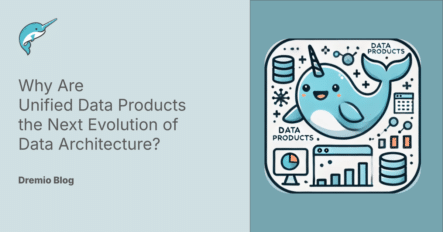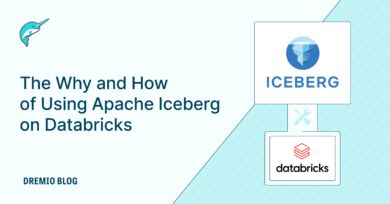9 minute read · February 28, 2025
Why Are Unified Data Products the Next Evolution of Data Architecture?
· Head of DevRel, Dremio

Data architectures have undergone a significant transformation over the past few decades. Enterprises once relied on rigid, centralized data warehouses to store and process information. Then came the era of data lakes, which offered more flexibility but often lacked governance and structure. Now, as organizations grapple with vast amounts of diverse data across multiple platforms, the need for unified data products is becoming increasingly clear.
Unified data products represent the next stage in data architecture evolution, enabling businesses to unify, govern, and make data more accessible across distributed environments. Instead of treating data as a static asset locked within a single platform, unified data products ensure that curated, governed, and accessible datasets can be leveraged across tools, teams, and use cases.
The Evolution of Data Architecture: From Silos to Unified Data Products
The journey toward unified data products can be understood by looking at how data architectures have evolved:
- Traditional Databases and Data Warehouses: Early data architectures relied on structured databases that provided governance but were inflexible and difficult to scale.
- The Rise of Data Lakes: To address scalability challenges, data lakes allowed enterprises to store raw, unstructured, and semi-structured data in cloud storage. However, governance and accessibility issues arose, making data difficult to operationalize.
- Lakehouse Architecture: The emergence of the lakehouse model combined the governance of warehouses with the flexibility of lakes, offering improved data reliability and structure.
- Unified Data Products: The next evolution builds on lakehouses by making data easily discoverable, governed, and queryable across multiple platforms. Instead of centralizing all data into a single location, unified data products allow for a distributed yet cohesive data strategy.
With data existing across on-premises databases, cloud storage, data warehouses, and third-party datasets, organizations need a strategy that unifies access, governance, and analytics. This is where unified data products come into play.
What Are Unified Data Products?
Unified data products take the concept of modern data management a step further by treating data as a product that can be managed with clear ownership, accountability, and governance.
A data product is more than just a dataset—a well-defined, curated, and governed entity serving a specific business purpose. Just as a traditional product manager oversees software product development, iteration, and distribution, unified data products require a similar approach.
Key attributes of unified data products include:
- Governance and Security: Enforcing consistent policies, lineage tracking, and access control.
- Interoperability Across Platforms: Supporting multiple storage formats, query engines, and compute environments.
- Curated and Versioned Data: Ensuring high-quality, well-documented data that remains trustworthy and reproducible.
- Self-Service Access for BI and AI: Providing an easy way for business analysts, data scientists, and engineers to consume and build upon shared data.
Instead of requiring organizations to consolidate all their data into one platform, unified data products make it possible to query and analyze distributed data seamlessly. This enables more flexibility, scalability, and accessibility for enterprises with complex data ecosystems.
Accelerating Unified Data Products with the Dremio Platform
Organizations seeking to implement unified data products need a robust data platform that unifies, models, governs, documents, and accelerates data access. Dremio provides the key capabilities necessary to enable unified data products at scale:
- Unification of Data: Dremio is a central access layer for data across databases, data warehouses, data lakes, and data lakehouses. Dremio enables organizations to integrate data from multiple sources without duplication.
- Modeling and Documentation with dbt: By integrating with dbt, Dremio allows teams to define, document, and manage data products in a git-versioned, code-based environment for auditability and disaster recovery.
- Governance and Security: Dremio’s built-in governance framework ensures that data remains secure and adheres to compliance policies across teams and tools.
- Acceleration with Reflections: By leveraging Dremio’s Reflections technology, organizations can optimize query performance and ensure that unified data products can be accessed efficiently.
- A Single Access Point for BI and AI: Dremio eliminates the need for multiple data silos by providing a unified interface for all data consumers, ensuring seamless access for both business intelligence and AI workloads.
The Role of Dremio’s Advanced Features in Unified Data Product Strategy
Organizations must adopt open, interoperable data architectures to fully realize unified data products' benefits. Dremio provides the foundational components to make this possible:
- Dremio Catalog (Private Preview): Dremio’s integrated catalog powered by Apache Polaris (incubating) offers portable metadata management, ensuring interoperability across different query engines and tools. Dremio
- Robust Apache Iceberg Support: Apache Iceberg has become the de facto open table format for modern lakehouse architectures. Dremio provides deep integration with Iceberg, enabling organizations to adopt a high-performance, flexible, and scalable data strategy.
- Unifying Lakehouse Data with the Long Tail of Data: Many enterprises have core lakehouse data but rely on external sources. Dremio enables a unified approach, allowing organizations to unify diverse datasets without unnecessary duplication or movement.
The Future of Unified Data Products and Open Data Architecture
Unified data products represent a paradigm shift in enterprise data management. Instead of forcing all data into a single system, the focus shifts toward providing seamless, governed access to data across multiple systems.
This transformation is still in its early stages, and one of the biggest questions for the industry is how unified data products will be delivered at scale. Key challenges include:
- Standardizing data product definitions to ensure interoperability.
- Implementing unified governance frameworks across diverse data landscapes.
- Automating data product pipelines to support consistent delivery and updates.
- Balancing flexibility with compliance to meet business needs while maintaining security and regulatory adherence.
The companies building these solutions—Dremio among them—are betting on the future of data architecture. By leveraging open table formats, portable catalogs, and unified governance models, enterprises can unlock the full potential of their data.
Conclusion
As organizations shift toward unified data products, the key to success is adopting an open, flexible, and interoperable data strategy. Dremio stands at the forefront of this transformation, providing the tools necessary to unify, govern, document, and accelerate data products at scale.
By embracing unified data products, organizations can move beyond vendor lock-in, streamline data access for BI and AI, and future-proof their data architectures. With Dremio’s platform, enterprises can build the foundation for a truly unified, high-performance data ecosystem that meets the needs of modern data consumers.
Sign up for AI Ready Data content


